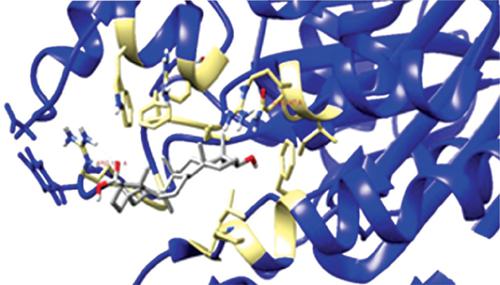Letters in Drug Design & Discovery ( IF 1.2 ) Pub Date : 2020-09-30 , DOI: 10.2174/1570180817999200514102750 Muhammad Ajmal Ali 1 , Mohammad Abul Farah 2 , Joongku Lee 3 , Khalid M. Al-Anazi 2 , Fahad Al-Hemaid 1

|
Aims: Medicinal plants like Citrullus colocynthis are a potential choice to produce helpful novel antimycobacterial drugs. The existence of a range of natural products in the plants, especially Ursolic Acid (UA) and cucurbitacin E 2-0-β-d-glucopyranoside (CEG), with promising antibacterial activity against a variety of bacteria, prompted the need to check its actions against Mycobacterium tuberculosis (Mtb).
Background: Mycobacterium tuberculosis (Mtb), an obligate human pathogen causes tuberculosis and is one of the major causes of death worldwide. A few combinations of drugs are currently accessible for treating TB patients, but these are inadequate to tackle worldwide TB cases.
Objective: The molecular interactions between ursolic acid and cucurbitacin E with the eight potential Mtb target proteins were investigated with the objective of finding drug-like inhibitors.
Methods: Avogadro v.1.2.0 and Openbabel v.2.4.1 were used for creating file formats required for docking analysis. Molecular docking was performed with eight different proteins essential for Mtb metabolism and survival. AutoDock v.4.2 and AutoDock vina v.1.1.2 were used for docking and Gromacs 5.1.4 was used for simulation studies.
Results and Discussion: Among the two ligands used in this research, cucurbitacin E showed a better docking score relative to the drugs presently available for all the target proteins. Rifampicin showed the best binding affinity (among known inhibitors) i.e. -10.8 kcal/mol with C terminal caspase recruitment domain. Moreover, ursolic acid and cucurbitacin E showed uniform binding score (above -7.5 kcal/mol) with all the target proteins, acknowledged its availability as a potential multi-target drug.
Conclusions: Ursolic acid can be useful in the creation of novel, multi-targeted and effective anti- TB medicines since it showed stable structure with FabH.
中文翻译:

蜂房中熊果酸和葫芦素与结核分枝杆菌治疗靶标相互作用的分子研究
目的:药用植物如柑桔(Citrullus colocynthis)是生产有用的新型抗分枝杆菌药物的潜在选择。植物中存在多种天然产物,尤其是熊果酸(UA)和葫芦素E2-0-β-d-吡喃葡萄糖苷(CEG),它们对各种细菌都有良好的抗菌活性,因此需要检查其结核分枝杆菌(Mtb)的作用。
背景:结核分枝杆菌(Mtb)是一种专性的人类病原体,可导致结核病,并且是全世界主要的死亡原因之一。目前可以使用几种药物组合来治疗结核病患者,但是这些药物不足以解决全世界的结核病病例。
目的:研究乌索酸和葫芦素E与8种潜在的Mtb靶蛋白之间的分子相互作用,以期发现类似药物的抑制剂。
方法:Avogadro v.1.2.0和Openbabel v.2.4.1用于创建停靠分析所需的文件格式。用Mtb代谢和生存所必需的八种不同蛋白质进行分子对接。使用AutoDock v.4.2和AutoDock vina v.1.1.2进行对接,使用Gromacs 5.1.4进行仿真研究。
结果与讨论:在这项研究中使用的两种配体中,葫芦素E相对于目前可用于所有靶蛋白的药物表现出更好的对接得分。利福平显示出最佳的结合亲和力(在已知抑制剂中),即具有C端半胱天冬酶募集结构域的-10.8 kcal / mol。此外,熊果酸和葫芦素E与所有靶蛋白均显示出均一的结合评分(-7.5 kcal / mol以上),并承认其可作为潜在的多靶点药物。
结论:熊果酸可用于制造新型,多靶点且有效的抗结核药物,因为它在FabH中显示出稳定的结构。











































 京公网安备 11010802027423号
京公网安备 11010802027423号